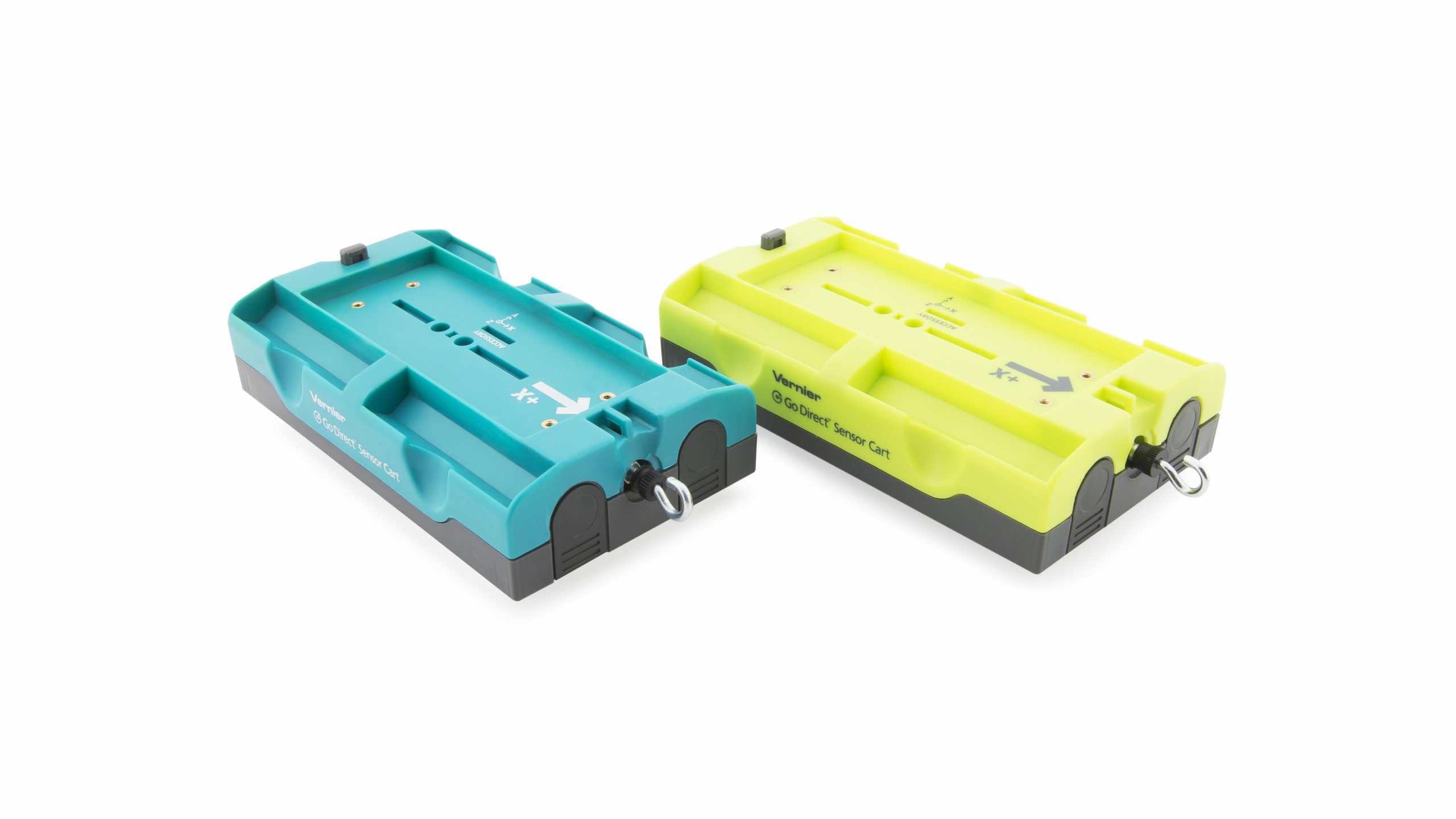Go Direct Sensor Carts
(GDX-CART-G or GDX-CART-Y)

Troubleshooting
Primary Test: Press the power button on the sensor to turn it on. Connect your sensor as described in the Getting Started instructions for your device. (The green LED will flash to indicate the sensor is connected.)
- Enable Position and Force sensor channels.
- View meter readouts of position and force.
- Roll cart on table in direction of force sensor. Does position reading increase?
- Push on force sensor. Does sensor respond with a negative reading?
Additional Troubleshooting
- What are the dimensions of the plastic dynamics carts?
- Can I use the Sensor Cart to measure simple weights and masses?
- How do I replace the wheels on a Go Direct Sensor Cart?
- Sensor cart position reading decreases when cart is moved in the +x direction.
- Why does my Sensor Cart force sensor not work when I attach something to the top of the cart?
- What are the specifications for the screw that secures the battery cover on a Go Direct Sensor Cart?
- What are the dimensions and threads of the mounting holes on Go Direct Sensor Carts?
- When collecting force data, why aren't the measured impulses synced?
- Go Direct sensor does not connect to LabQuest 2 via Bluetooth.
- How do I remove or replace a Go Direct battery?
- Troubleshooting Bluetooth Connections with Go Direct Sensors
- What can I do if a Go Direct sensor's Bluetooth LED flashes red and green when I try to connect to it and the connection fails?
- Will my device work with Go Direct Sensors via Bluetooth?
- How do I know if my LabQuest will work with Go Direct Sensors and Go Wireless devices?
Specifications
- Position sensor: 0.25 mm, reported to the nearest 1 mm
- Force sensor
⚬ Range: ±50 N
⚬ Response Time: 1 ms - Accelerometer sensor: Range: ±160 m/s²
- Dimensions:
⚬ Length: 16.6 cm, not including accessories mounted to the force sensor
⚬ Width: 9.6 cm
⚬ Height: 4.7 cm
⚬ Nominal Mass: 275 g excluding accessories - Accessory Port: Available for future expansion
- Connections:
⚬ Wireless: Bluetooth® v4.2 (wireless range 30 m unobstructed)
⚬ Wired: USB 2.0 full speed - Battery: 650 mAh Li-Poly
⚬ Battery Life (single, full charge): ~10 hours continuous data collection
⚬ Battery Life (lifetime): 2 – 5 years (typical)
Calibration
POSITION SENSOR
Calibrate? No. The position channel does not need, nor can it be, calibrated.
- The Position channel can be zeroed.
This is useful to establish a zero position on a track. Do not pick up the cart after zeroing to avoid disturbing the zero. - The Position Sensor can be reversed.
This is useful when using two carts in collision mode with force sensors facing one another. To put the two carts on the same coordinate system, reverse the direction of the position and force sensors on one cart, and zero the cart positions with the carts in contact.
FORCE SENSOR
Calibrate? Generally, no. This sensor is factory calibrated. For more information, see How do I calibrate my sensor?
- Two Point Calibration
⚬ First Point: no force applied
⚬ Second Point: a known force applied. We recommend a 1 kg mass (9.8 N).
Do not exceed the maximum of 50 N during calibration. - The Force Sensor can be zeroed.
This is useful after calibration to remove the weight of the hook. - The Force Sensor can be reversed so that push is positive.
ACCELEROMETERS (X-, Y-, and Z-AXIS)
Calibrate? Generally, no. This sensor is factory calibrated. For more information, see How do you calibrate an accelerometer?
- Two Point Calibration
⚬ First Point: accelerometer aligned perpendicular to Earth’s gravitational field. (0 m/s²)
⚬ Second Point: aligned parallel to Earth’s gravitational Field. (± 9.8 m/s² depending on orientation) - The Accelerometers can be zeroed.
Battery Troubleshooting
- If the sensor can be turned on when connected by USB but not when disconnected from USB, the battery likely needs charging.
⚬ Charge the sensor for several hours and try again. - If the sensor shows fully charged but still won’t turn on when connected via USB, then the battery has likely disconnected.
⚬ Check the battery connection. - If the sensor still won’t turn on, try swapping the battery with a working sensor to see if the problem follows the battery or stays with the sensor.
⚬ If the problem stays with the sensor, the battery is probably not the issue.
⚬ If the problem follows the battery, the battery has likely reached its end of life. - If the battery is indeed at the end of its life, the sensor cannot be used even if connected by USB, so the battery will need to be replaced. Go Direct® 650 mAh Replacement Battery (
GDX-BAT-650 ) - See How do I remove or replace a Go Direct battery? for more information.
Rechargeable batteries are covered by a one-year warranty.
Batteries should last two to five years in typical use.
Related Products
- Micro USB to USB-C Cable (
CB-USB-C-MICRO ) - Go Direct® Sensor Cart Charge Station (
GDX-CART-CRG ) - Go Direct® Sensor Cart Accessory Kit (
GDX-CART-AK ) - Cart Fan (
DTS-CFAN ) - Friction Pad DTS (
DTS-PAD ) - Eddy Current Brake (
DTS-ECB ) - Cart Guide (
CGUIDE-10 ) - Combination Track/Optics Bench (
TRACK ) - Motion Encoder Cart and Receiver (
DTS-MEC )
Replacement Parts
- Go Direct® 650 mAh Replacement Battery (
GDX-BAT-650 ) - Micro USB Cable (
CB-USB-MICRO ) - Vernier Dynamics System Axles and Wheels for Cart (
WHEELS-VDS ) - Anti-Roll Pegs (10 Pack) (
VDS-ARP10 ) - Dual-Range Force Sensor Replacement Parts Kit (
DFS-RPK ) - Dynamics Cart Replacement Tabs (
DTS-TABS )
